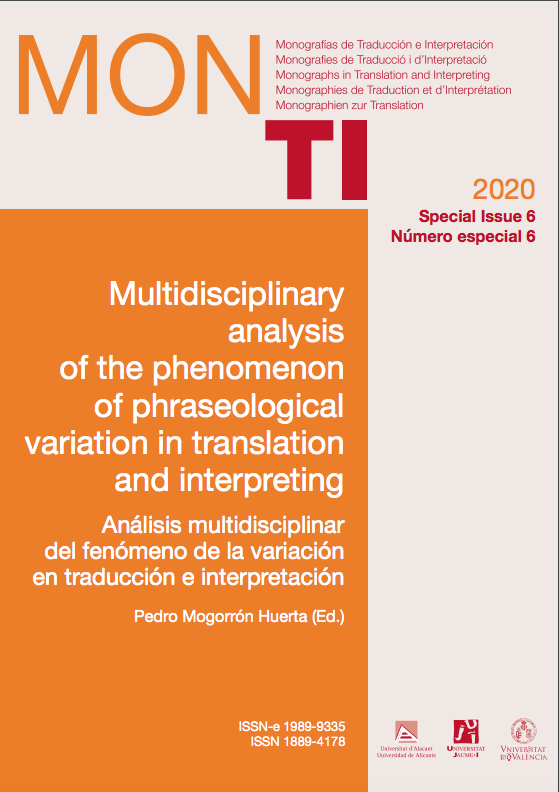Cognitive approach to the phraseological variation some conceptualizations of mental illness in Italian and the implications for their translation into Spanish and German
Main Article Content
Abstract
Cognitive linguistics has highlighted the tendency of human beings to understand reality through conceptual transfers between different domains, that can be conventional in the mind and create lexicalized expressions with a figurative value in every language. A cognitive approach to the study of phraseology variation will be proposed by taking into consideration a number of Italian phraseological units that refer to people whose mental faculties are in an altered condition, in order to determine their mutual conceptual correlation. Subsequently, the way in which the existence of the identified variants can influence the whole translation process will be studied, from their recognition and interpretation to their actual translation, as well as the translator’s cognitive effort. In this phase, Spanish and German will be considered as hypothetical target languages.
Downloads
Article Details
The documents contained in these directories are included by the contributing authors as a means to ensure timely dissemination of scholarly and technical work on a non-commercial basis. It is understood that all persons copying this information will adhere to the terms and constraints invoked by each author's copyright. These works may not be reposted without the explicit permission of the copyright holder.
References
Arribas, Nieve. (2006) “Consideraciones metalexicográficas sobre fraseología y lexicografía italo-españolas.” Quaderni del CIRSIL 5, pp. 153-184.
Baker, Mona. (1992) In Other Words: A Coursebook on Translation. New York: Routledge.
Black, Max. (1962) Models and metaphors: Studies in language and philosophy. Ithaca: Cornell University Press.
Cacciari, Cristina. (2001) Psicologia del linguaggio. Bologna: Il Mulino. Castillo Carballo, María Auxiliadora. (1997-1998) “El concepto de unidad fraseológica.” Revista de Lexicografía 4, pp. 67-79.
Corpas Pastor, Gloria & Florentina Mena Martínez. (2003) “Aproximación a la variabilidad fraseológica de las lenguas alemana, inglesa y española.” ELUA. Estudios de Lingüística 17, pp. 181-201.
Corpas Pastor, Gloria. (1996) Manual de fraseología española. Madrid: Gredos.
Corpas Pastor, Gloria. (2001) “Corrientes actuales de la investigación fraseológica en Europa.” EUSKERA 46:1, pp. 21-49.
Corpas Pastor, Gloria. (2003) Diez años de investigación en fraseología: análisis sintáctico-semánticos, contrastivos y traductológicos. Madrid: Vervuert.
Dobrovol’skij, Dmitrij. (2016) “Conceptual structure and systematic variation of Russian idioms.” In: Dal Maso, Elena & Carmen Navarro (eds.) 2016. Gutta cavat lapidem Indagini fraseologiche. Mantova: Universitas Studiorum, pp. 27-37.
García Page, Mario. (2016) “Variantes léxicas correlativas.” In: Dal Maso, Elena & Carmen Navarro (eds.) 2016. Gutta cavat lapidem Indagini fraseologiche. Mantova: Universitas Studiorum, pp. 39-54.
Goatly, Andrew. (1997) The language of metaphors. London: Routledge.
González Rey, María Isabel. (1998) “Estudio de la idiomaticidad en las unidades fraseológicas.” In: Wotjak, Gerd (ed.) 1998. Estudios de fraseología y fraseografía del español. Frankfurt am Main/Madrid: Vervuert/Iberoamericana, pp. 57-73.
Keysar, Boaz & Benjamin Bly. (1995) “Intuitions of the transparency of idioms: Can you keep a secret by spilling the beans?” Journal of Memory and Language 34, pp. 89-109.
Kövecses, Zoltan. (1986) Metaphors of anger, pride, and love: a lexical approach to the structure of concepts. Amsterdam: John Benjamins.
Kövecses, Zoltan. (2002) Metaphor. A practical Introduction. Oxford: Oxford University Press.
Kövecses, Zoltan. (2005) Metaphor in culture: universality and variation. Cambridge: Cambridge University Press.
Kövecses, Zoltan. (2010a) “A new look at metaphorical creativity in cognitive linguistics.” Cognitive Linguistics 21:4, pp. 663–697.
Kövecses, Zoltan. (2010b) “Metaphor and Culture.” Acta Universitatis Sapientiae, Philologica 2:2, pp. 197-220.
Kövecses, Zoltan. (2010c) “Metaphor, Creativity, and Discourse.” DELTA 26, pp. 719-738.
Lakoff, George & Mark Johnson. (1980) Metaphors we live by. Chicago/London: The University of Chicago Press.
Langlotz, Andreas. (2006) Idiomatic Creativity. A cognitive-linguistic model of idiom-representation and idiom-variation in English. Amsterdam & Philadelphia: John Benjamins Publishing Company.
Mandelblit, Nili. (1995) “The cognitive view of metaphor and its implications for translation theory.” In: Thelen, Marcel & Barbara Lewandowska-Tomaszczyk (eds.) 1996. TRANSLATION AND MEANING, Part 3. Maastricht: Hogeschool Maastricht, School of Translation and Interpreting, pp. 483-495.
Montoro Del Arco, Esteban Tomás. (2004) “La variación fraseológica y el diccionario.” In: Battaner, Paz & DeCesaris, Janet Ann (eds.) 2004. De lexicografia: actes del I Symposium Internacional de Lexicografia. Barcelona: Institut Universitari de Lingüística Aplicada, pp. 591-604.
Quiroga, Paula. (2006) Fraseología italo-española: Aspectos de lingüística aplicada y contrastiva. Granada: Granada Lingvistica.
Richards, Ivor Armstrong. (1936) The Philosophy of Rhetoric. New York/London: Oxford University Press.
Sjørup, Annette Camille. (2013) Cognitive effort in metaphor translation. An eyetracking and key-logging study. Copenhagen: LIMAC PhD School. Tesi di dottorato.
Steen, Gerard. (2014) “Translating metaphor: What’s the problem?” In: Monti, Enrico & Donna Rose Miller (eds.) 2014. Tradurre figure. Translating figurative language. Quaderni del CeSLiC. Atti di Convegni (3). Bologna: Centro di Studi Linguistico-Culturali (CeSLiC), pp. 11-24.
Timofeeva, Larissa. (2012) “Sobre la traducción fraseológica.” ELUA 26, pp. 405-432.
Vega Moreno, Rosa. (2005) “Idioms, Transparency and Pragmatic Inference.” UCL Working Papers in Linguistics 17, pp. 389-426.
Zuluaga, Alberto. (1980) Introducción al estudio de las expresiones fijas. Francoforte/Berna: Peter Lang.
Zuluaga, Alberto. (1999) “Traductología y Fraseología.” Paremia 8:5, pp. 537-549.


